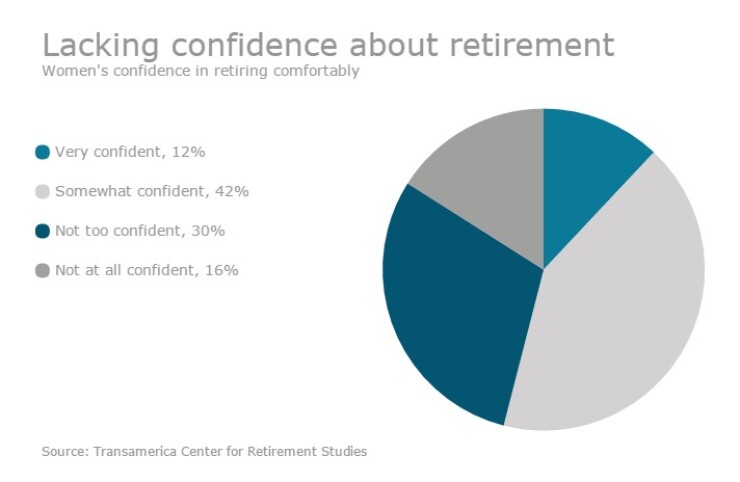Women are still not saving enough for retirement and the situation continues to deteriorate.
Many industry reports have highlighted the bleak situation most women will find themselves in once they reach retirement age. Women are far more likely than men to face financial hardships in retirement, according to the National Institute on Retirement Security in its report, Shortchanged in Retirement: The Continuing Challenges to Women’s Financial Future.
Across all age groups, women have substantially less income in retirement than men and by age 65, 80% of women are more likely than men to live in poverty. From ages 75 to 79, women are three times more likely to fall below the poverty line than men of the same age, according to NIRS.

“It is well documented that the nation faces a retirement savings crisis, but the pain is particularly severe for women because we need a bigger retirement nest egg than men thanks to our longer life expectancy,” says Diane Oakley, NIRS executive director and a co-author of the report. “This new data is troubling — it shows that a woman’s nest egg is substantially smaller than a man’s and that we’re not making real headway toward closing the retirement gender gap.”
The fact that a high majority of women will fall into poverty when they reach age 65 or older is a fact that “should be a call to action for policymakers,” she believes. “Women are financially disadvantaged because we still earn less than men and we typically take time out of our careers for caregiving — both of which reduce our ability to prepare for retirement. As a result, more women are spending their retirement years working.”
“It is well documented that the nation faces a retirement savings crisis, but the pain is particularly severe for women.”
In 2010, men received $17,856 in median retirement income from a pension while women received 33% less, or $12,000. In 401(k) plans, men also had 34% more in their accounts than women, according to data from Vanguard.
It will be hard to bridge this gap as long as women find themselves taking care of children and then elderly parents or a spouse.
Women who need to step out of the workforce for one reason or another end up earning less in Social Security benefits and they lose out on the income they could have made if they were able to work full-time, Oakley says.
“All of that poses issues as well. Sooner or later you expect your spouse is going to pass and you will be on your own. Most women don’t understand how long that typically is: somewhere between 10 to 14 years on your own,” she says.
And while women are actually working at employers that offer pensions, more so than men, they may be losing out because they are working part-time or not enough hours to be eligible for the plan, Oakley says.
President Obama introduced a plan in his newest budget that would allow long-term part-time employees, who have worked three consecutive years of 500 hours, to be eligible to participate in an employer’s defined contribution plan, either a 401(k) or a 403(b).
Oakley says it’s disheartening that many women need to rely on Social Security as their primary means of retirement income.
Moreover, defined contribution plans were never designed to produce guaranteed income. Vanguard reported that the typical female has $25,000 in her DC plan at work. That amount “isn’t going to last someone’s lifetime and give them extra support. Those are the tough things,” Oakley says.
Out of pocket healthcare costs can also erode retirement savings. “Most of us don’t have enough to take care of healthcare. That will be deducted from Social Security but we need something to pick up the balance of that and pick up housing,” Oakley says.
Employers can help by using automatic features like auto enrollment and auto escalation to get employees to save more in their workplace retirement accounts.
Running out of money
People’s biggest financial concern, says Oakley, is running out of money in retirement.
One way to combat that eventuality is to have a financial plan, even if it is a very basic one. That plan must dedicate some savings to retirement, she says.
Oakley points out that teachers and nurses tend to be better off financially than women who choose other career paths, in large part because those professions have access to defined benefit plans. Even though they get paid less, they’re forced to save for retirement.
“It just shows the real benefit of having forced savings, consistently throughout your career. It does make a difference,” she says. “That’s why the idea of making sure we expand coverage has got to be much more of a goal.”
The Employee Retirement Income Security Act was never passed to expand retirement coverage but to protect pensions that were already in place. Since 1974, when ERISA was passed, “we really haven’t changed the percentage of workers who were covered under pension plans. Maybe that needs to be a goal,” says Oakley.
Employers need to offer ways for employees to save at work so that it is taken out of their paychecks before they ever see it.
“It is a huge economic issue,” she says.





